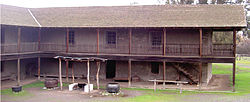Rancho Petaluma Adobe
| Rancho Petaluma Adobe | |
|---|---|

Rancho Petaluma Adobe, California
|
|
| General information | |
| Town or city | east of Petaluma, California |
| Country | United States |
| Coordinates | 38°15′20″N 122°35′04″W / 38.25547°N 122.58451°WCoordinates: 38°15′20″N 122°35′04″W / 38.25547°N 122.58451°W |
| Construction started | 1834 |
| Completed | 1857 |
| Cost | $80,000 |
| Client | Mariano Guadalupe Vallejo |
| Technical details | |
| Structural system | adobe brick and timber |
| Size | 200 x 145 feet (44.2 m) |
|
Petaluma Adobe
|
|
 |
|
| Location | Casa Grande Road, Petaluma, California |
| Area | 5 acres (2.0 ha) |
| Built | 1836 |
| Architectural style | Adobe/Monterey Colonial |
| NRHP Reference # | 70000151 |
| CHISL # | 18 |
| Significant dates | |
| Added to NRHP | April 15, 1970 |
| Designated NHL | April 15, 1970 |
| Designated CHISL | June 1, 1932 |
Rancho Petaluma Adobe is the name of a historic ranch house built from adobe bricks by order of Mariano Guadalupe Vallejo. It was the largest privately owned adobe structure built in California and is the largest example of the Monterey Colonial style of architecture in the United States. A section of the Adobe has been preserved by the Petaluma Adobe State Historic Park and is both a California Historic Landmark and a National Historic Landmark. The Rancho Petaluma Adobe State Historic Park is located on Adobe Road on the east side of the present-day town of Petaluma, California.
The Adobe was designed to function both as a headquarters of a working ranch and as a defensive structure against attack by the Russians then living on the California coast or the borderland's native tribes. It consisted of two, two-story buildings surrounding an open courtyard of roughly 200 ft × 145 ft (61 m × 44 m). It was built using adobe bricks and hand-hewn redwood timbers and planks. The building had planked floors and a low-sloped shingled roof. The wide, covered second-story veranda encased and protected the adobe walls from the weather and provided advantageous firing positions in case of an attack. There were large gates located between the buildings on the south and north sides of the quadrangle.
The southwest section of the building contained the Vallejo family living area when they visited the ranch. Some walls were plastered and whitewashed. The outdoor kitchen and the dining room (featuring imported glass windows) were on the ground floor. The second floor of the “fort" (as it was called by Vallejo) housed the family's sleeping rooms, Vallejo's office, the sleeping room for the ranch manager, guest rooms, and communal sleeping areas for the most privileged workers. The downstairs dining room and the rooms of the family and manager had interior fireplaces.
Construction of the eastern building was never fully completed. The walls were built but without floors or a roof. That building no longer exists, so what remains of the Petaluma Adobe is only half its former size.
In 1834, California Governor José Figueroa ordered Lieutenant (Teniente) Vallejo and his soldiers from the Presidio of San Francisco to move north of the Bay. He granted Vallejo the initial lands of Rancho Petaluma. During 1836 Vallejo began construction of the ranch house, eventually investing an estimated $80,000 in labor and materials. The planned structure was never fully completed. His younger brother Salvador Vallejo directed most of the construction. Between 1836 and 1839, at least 2,000 Native Americans were employed at the ranch to make bricks, haul lumber, build buildings, cook, farm, make tools, tan hides and tend the large herd of cattle.
...
Wikipedia


